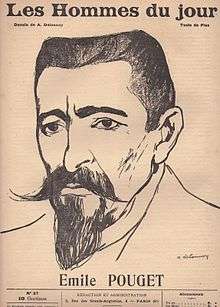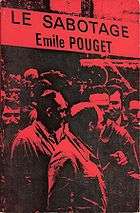Émile Pouget
| Émile Pouget | |
|---|---|
 Portrait by Aristide Delannoy | |
| Born |
October 12, 1860 Pont-de-Salars, Aveyron, France |
| Died |
July 21, 1931 (aged 70) Palaiseau, Essonne, France |
| Occupation | Anarchist writer and activist |
| Nationality | French |
Émile Pouget (12 October 1860 in Pont-de-Salars, Aveyron, now Lozère – 21 July 1931 Palaiseau, Essonne) was a French anarcho-communist,[1] who adopted tactics close to those of anarcho-syndicalism. He was vice-secretary of the General Confederation of Labour from 1901 to 1908.
Biography

As a young man, Pouget founded his first newspaper, Le Lycéen républicain (The Republican Student) at high-school, being revolted at the trial of the Narbonne's Communards in Rodez.
He participated as soon as 1879, aged 19, at the creation of a textile union, the Syndicat des employés du textile. He then joined in 1881 a group of French anarchists at the London International Congress, following the dissolving of the First International.
Pouget was arrested on March 9, 1883, following a demonstration in Paris by unemployed people, during which three breadshops were pillaged. He was detained while trying to free Louise Michel from the police's hands. Condemned to 8 years prison for "armed pillage", Pouget was detained from 1883 to 1886 at Melun's prison.
Once freed, he started on 24 February 1889, the publication of Le Père Peinard. Following the 1894 assassination of President Sadi Carnot and the ensuing repression in the ranks of the anarchist movement, he exiled himself to England in order to avoid being judged during the Trial of the thirty. He returned to France only after the 1895 amnesty granted by president Félix Faure.
Starting in 1896, he preconized sabotage actions as means of struggle, a view expressed in various articles and leaflets. From 1901 to 1908 he was elected vice-secretary of the General Confederation of Labour (CGT) trade-union, representing the anarcho-syndicalist tendency in the union. Pouget thereafter participated in the drafting of the 1906 Charte d'Amiens, which set the foundations of the French trade-union movement. The following year, he became chief editor of La Voix du Peuple (The Voice of the People), edited by the CGT. Eventually, in 1909, he distanced himself from the trade union movement.
Footnotes
- ↑ The Anarchist Papers III, page 97
Works
| Wikisource has original text related to this article: |
- Almanach du Père Peinard, Paris, 1894 (in French)
- Almanach du Père Peinard, Paris, 1896
- Almanach du Père Peinard, Paris, 1897
- Almanach du Père Peinard, Paris, 1898
- Comment nous ferons la Révolution, in collaboration with Émile Pataud, Paris, J. Taillandier, 1909
- L'action directe, Nancy, Édition du "Réveil ouvrier", coll. « Bibliothèque de documentation syndicale »
- La Confédération générale du travail, Bibliothèque du Mouvement Prolétarien, Librairie des sciences politiques et sociales Marcel Rivière, Paris, 1910
- Le Parti du Travail
- Le Sabotage, Mille et une nuits, coll. « La petite collection », Paris, 2004
- Les Caractères de l'action directe
- Les lois scélérates de 1893-1894, en collaboration avec Francis de Pressensé, Paris, Éditions de la "Revue blanche", 1899
Articles
- Barbarie française, Le Père Peinard, n°45, 12 janvier 1890
- Faramineuse consultation sur l'avenir, Almanach du Père Peinard, Paris, 1896
- Jabotage entre bibi et un fiston, Almanach du Père Peinard, Paris, 1894
- L'Automne, Almanach du Père Peinard, 1896
- L'été, Almanach du Père Peinard, 1897
- L'Hiver, Almanach du Père Peinard, 1897
- Le Muselage Universel, Almanach du Père Peinard, 1896
- Le Printemps, Almanach du Père Peinard, 1897
- Le Sabotage, Almanach du Père Peinard, Paris, 1898
- Les Lois Scélérates de 1893-1894, Éditions de la Revue blanche, 1899
- Patron assassin, Le Père Peinard, 4 juin 1893
- Pourquoi et comment Le Père Peinard s'est bombardé Journaleux, Almanach du Père Peinard, 1894
- Qu'on châtre la frocaille ! En attendant mieux, Le Monde libertaire, 31 janvier 2002
- Un cochon, Le Père Peinard, 10 août 1890
Bibliography
- Roger Langlais, Émile Pouget, Le Père Peinard, Éditions Galilée, 1976
- François Bott, « Le Père Peinard, ce drôle de Sioux », Le Monde, 30 janvier 1976.
- Dominique Grisoni, « Le Père Peinard de la révolution », Le Magazine Littéraire, n°111, avril 1976, 42-43.
- Emmanuel de Waresquiel, Le Siècle rebelle, dictionnaire de la contestation au XXe siècle, Larousse, coll. « In Extenso », 1999.

- Xose Ulla Quiben, Émile Pouget, la plume rouge et noire du Père Peinard, Éditions Libertaires, 2006.
- Emile Pouget, Le Père Peinard, Journal espatrouillant. Articles choisis (1889–1900). Les Nuits rouges, 2006 .
References
- Dominique Sommier, Émile Pouget et Le Père Peinard, Almanach et hebdomadaire anarchiste (1889-1902), sur 19e.org, 2004.
- Lucien Orsane, À la mémoire d'Emile Pouget, Anarchiste syndicaliste révolutionnaire aveyronnais 1860-1931, sur Jccabanel.free.fr.
- Paco, La Plume rouge et noire du « Père Peinard », sur Monde-libertaire.info, 2006.

- Paul Delesalle, Émile Pouget, Histoire du syndicalisme révolutionnaire et de l'anarcho-syndicalisme, sur Pelloutier.net.
External links
| Wikimedia Commons has media related to Émile Pouget. |

